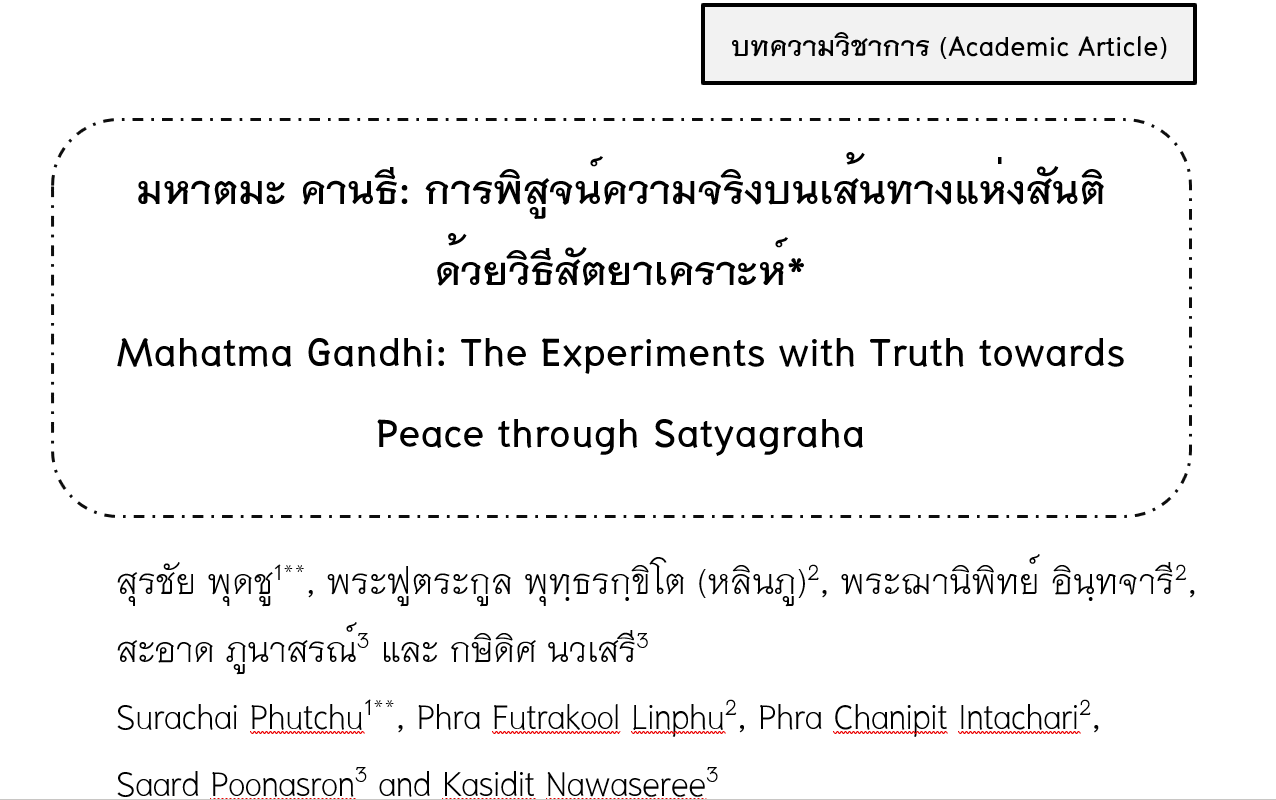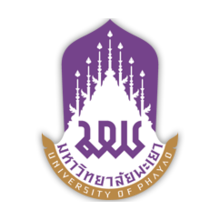Mahatma Gandhi: The Experiments with Truth towards Peace through Satyagraha
Keywords:
Mahatma Gandhi, Experiments with Truth, Peace Ways, SatyagrahaAbstract
This article has objective to study the concept of Mahatma Gandhi who performs Satyagraha that means firmness in Truth in order to require peace in Indian society. Gandhi has begun to perform this approach to require the fairness for Indian workers in South Africa. When he came back motherland he performs the same struggle as South Africa. The principles of Satyagraha consist of three components are as follows: 1) God is the Truth; 2) the way reached the Truth is Non-violence; and 3) Non-violence will be happened by Self-sacrifice. These principles are the experiments with truth of Gandhi that is the attainment to God. Hence, Satyagraha which appeals in his struggle movement to opponents is self-struggle as well. It is the attainment of internal and external peace. Internal peace is to face the truth himself which is similar to attain God. Latter one is to meet the requirement for self-rules of Indians. For this reason, Gandhi’s ideas are divided into three theories and performances of struggle movement as follow: 1) philosophy: it is a middle way to improve human beings’ ability, especially to achieve the superman through master morality; 2) religion: it is a practical way to integrate all religious teachings about non-violence and to obtain the goal of religion by facing the truth; and 3) leadership: his approach can persuade people to follow voluntarily, so he is the super leadership who can lead people to lead others. Therefore, Gandhi’s leadership is properly affixed name as “Mahatma,” means “Great Soul.” From the way that Gandhi has fought with the above principles of Satyagraha, it becomes the true peace, both of internal and external.
References
จำนงค์ อดิวัฒนสิทธิ์. (2525). ประวัติแนวคิดทางสังคม (History of Social Thought). กรุงเทพฯ: สำนักพิมพ์โอเดียน สโตร์.
นิโคลสัน, ไมเคิล, เขียน. วรรธนา วงษ์ฉัตร, แปล. (2540). มหาตมา คานธี นักบุญผู้ยิ่งใหญ่. กรุงเทพฯ: ดอกหญ้า.
มหาตมา คานธี, เขียน. กรุณา กุศลาสัย, แปล. (2562). ข้าพเจ้าทดลองความจริง: อัตชีวประวัติของมหาตมา คานธี (พิมพ์ครั้งที่ 8). กรุงเทพฯ: สถานทูตอินเดีย.
มหาวิทยาลัยมหาจุฬาลงกรณราชวิทยาลัย. (2539). พระไตรปิฎกภาษาไทย ฉบับมหาจุฬาลงกรณราชวิทยาลัย เล่ม 25. กรุงเทพฯ: โรงพิมพ์มหาจุฬาลงกรณราชวิทยาลัย.
ราชบัณฑิตยสถาน. (2548). พจนานุกรมศัพท์ปรัชญาอังกฤษ-ไทย ฉบับราชบัณฑิตยสถาน (พิมพ์ครั้งที่ 4). กรุงเทพฯ: ราชบัณฑิตยสถาน.
เรือรบ เมืองมั่น. (2536). มหาตมะ คานธี กับการพยายามแก้ไขปัญหาความขัดแย้งระหว่างฮินดูกับมุสลิม (รายงานการวิจัย). กรุงเทพฯ: อาศรมวัฒนธรรมไทย-ภารต.
วิทย์ วิศทเวทย์. (2547). ปรัชญาทั่วไป: มนุษย์ โลกและความหมายของชีวิต (พิมพ์ครั้งที่ 17). กรุงเทพฯ: สำนักพิมพ์อักษรเจริญทัศน์.
ศูนย์อินเดียศึกษาแห่งจุฬาลงกรณ์มหาวิทยาลัย และสำนักบริหารศิลปวัฒนธรรม จุฬาลงกรณ์มหาวิทยาลัย. (2562). นิทรรศการ “ชีวิตมหาตมาคานธี” (The Life of Mahatma Gandhi). วันที่ 2 ตุลาคม-12 พฤศจิกายน 2562 ณ นิทรรศสถาน อาคารศิลปวัฒนธรรม จุฬาลงกรณ์มหาวิทยาลัย. เก็บข้อมูลภาคสนาม.
สถาบันวิจัยภาษาเเละวัฒนธรรมอินเดีย มหาวิทยาลัยมหิดล ร่วมกับสถานเอกอัครราชทูตอินเดียประจำประเทศไทย. (2552). เเนวคิดเเละภูมิปัญญาของอินเดีย ครั้งที่ 1 เรื่องเเนวพระราชดำริปรัชญาเศรษฐกิจพอเพียงของในหลวงกับเเนวคิดการพึ่งพาตนเองของมหาตมา คานธี. กรุงเทพฯ: โรงพิมพ์ห้างหุ้นส่วนจำกัดสามลดา.
สมัคร บุราวาศ. (2544). วิชาปรัชญา (พิมพ์ครั้งที่ 4). กรุงเทพฯ: สำนักพิมพ์ศยาม.
สุจิตรา อ่อนค้อม. (2548). ปรัชญาเบื้องต้น (พิมพ์ครั้งที่ 7). กรุงเทพฯ: บริษัทอักษราพิพัฒน์ จำกัด.
Burns, J. M. (2003). Transforming Leadership: A New Pursuit of Happiness. New York: Grove Press.
Dalton, D. (2012). Mahatma Gandhi: Nonviolent Power in Action. New York: Columbia University Press.
Encyclopedia. (2020). Maslow's Hierarchy of Needs. Retrieved 8 March 2020, From https://www.encyclopedia.com/medicine/encyclopedias-almanacs-transcripts-and-maps/maslows-hierarchy-needs.
Gandhi, M. K. (1968). written. Valji Govindji Desai, tran. Satyagraha in South Africa: The Selected Works of Mahatma Gandhi Vol. II. Ahmedabad: Jitendra T. Desai Navajivan Publishing House.
Jordens, J. T. F. (1998). Gandhi’s Religion: A Homespun Shawl. New York: St. Martin’s Press, Inc.
Lelyveld, J. (2012). Great Soul: Mahatma Gandhi and His Struggle with India. New York: Vintage Books.
Masih, Y. (1975). A Critical History of Modern Philosophy. Delhi: Motilal Banarsidass.
O'Toole, J. (2008). Notes Toward a Definition of Values-Based Leaders. The Journal of Values-Based Leadership, 1(1), 1-9.
Rajendra Prasad. (1949). Satyagraha in Champaran. Ahmedabad: Navajivan Publishing House. Stanford Encyclopedia of Philosophy. (27 February 2020). Nietzsche’s Moral and Political Philosophy. Retrieved March 8, 2020, from https://plato.stanford.edu/entries/nietzsche-moral-political/.
The Internet Encyclopedia of Philosophy. Jain Philosophy. Retrieved March 8, 2020, from https://www.iep.utm.edu/jain/.

Downloads
Published
How to Cite
Issue
Section
License
Copyright (c) 2022 Phayao University

This work is licensed under a Creative Commons Attribution-NonCommercial-NoDerivatives 4.0 International License.
ผู้นิพนธ์ต้องรับผิดชอบข้อความในบทนิพนธ์ของตน มหาวิทยาลัยพะเยาไม่จำเป็นต้องเห็นด้วยกับบทความที่ตีพิมพ์เสมอไป ผู้สนใจสามารถคัดลอก และนำไปใช้ได้ แต่จะต้องขออนุมัติเจ้าของ และได้รับการอนุมัติเป็นลายลักษณ์อักษรก่อน พร้อมกับมีการอ้างอิงและกล่าวคำขอบคุณให้ถูกต้องด้วย
The authors are themselves responsible for their contents. Signed articles may not always reflect the opinion of University of Phayao. The articles can be reproduced and reprinted, provided that permission is given by the authors and acknowledgement must be given.







